
Melanodendron, D.C.
361. *M. integrifolium, D.C.; Solidago integrifolia, Eoxb.—
The native Black Cabbage-tree grows to a large, handsome, spreading
tree, about fifteen feet high, on each side of the central ridge;
now the most abundant of all. I t is covered with masses of
white blossoms in the months of October and November; P l a t e 40.
Also Hk. Icon. Plant. 1045.
Psiadia, Jacq.
362. *P. rotundifolia, Hk. f.; Sol}dago rotundifolia, Eoxb.—Only
one tree of this species is now known to exist in the world, and that
grows in a field to the left of the entrance gates at Longwood,
called The Black Field. Eoxburgh states that the islander^
called it Bastard Gum Wood, or Cabbage-tree. After a careful search,
extending over a year or more, the plant above mentioned was
discovered in the year 1868. I t is a tree about twenty feet in
height, and apparently very old. I t grows side by side with a
Gum Wood, and without close examination might be mistaken for
that species; indeed, I discovered it only by riding up to it to look
for blossoms of the Gum Wood, and was surprised to find it
covered with small white flowers of a different plant. I t is much to
be desired that a plant of such singular interest should be propagated
before it is entirely lost. I t flowers in May and June.
P l a t e 41.
Beilis, Linn.
363. B. perennis, Linn.—Common Daisy; grown in gardens, and
is very rare, notwithstanding the many efforts which have been
made to naturalize it.—Hab. Europe, N. Africa, &c.
Tribe H e l i a n t h o l d e .® .
Blainvillea, Cass.
364. B. rhomboidea, Cass.—A common weed on the rocky
ground in the neighbourhood of Barnes’ Eoad, &c. Flowers are white,
and appear in July. Wild and common. M. Alt. 1 to 2.—Hab. Brazil.
Dahlia, Cav.
365. D. variabilis, Desf.—Many varieties of Dahlia are cultivated
in the gardens on the high land, and flower and seed exceed